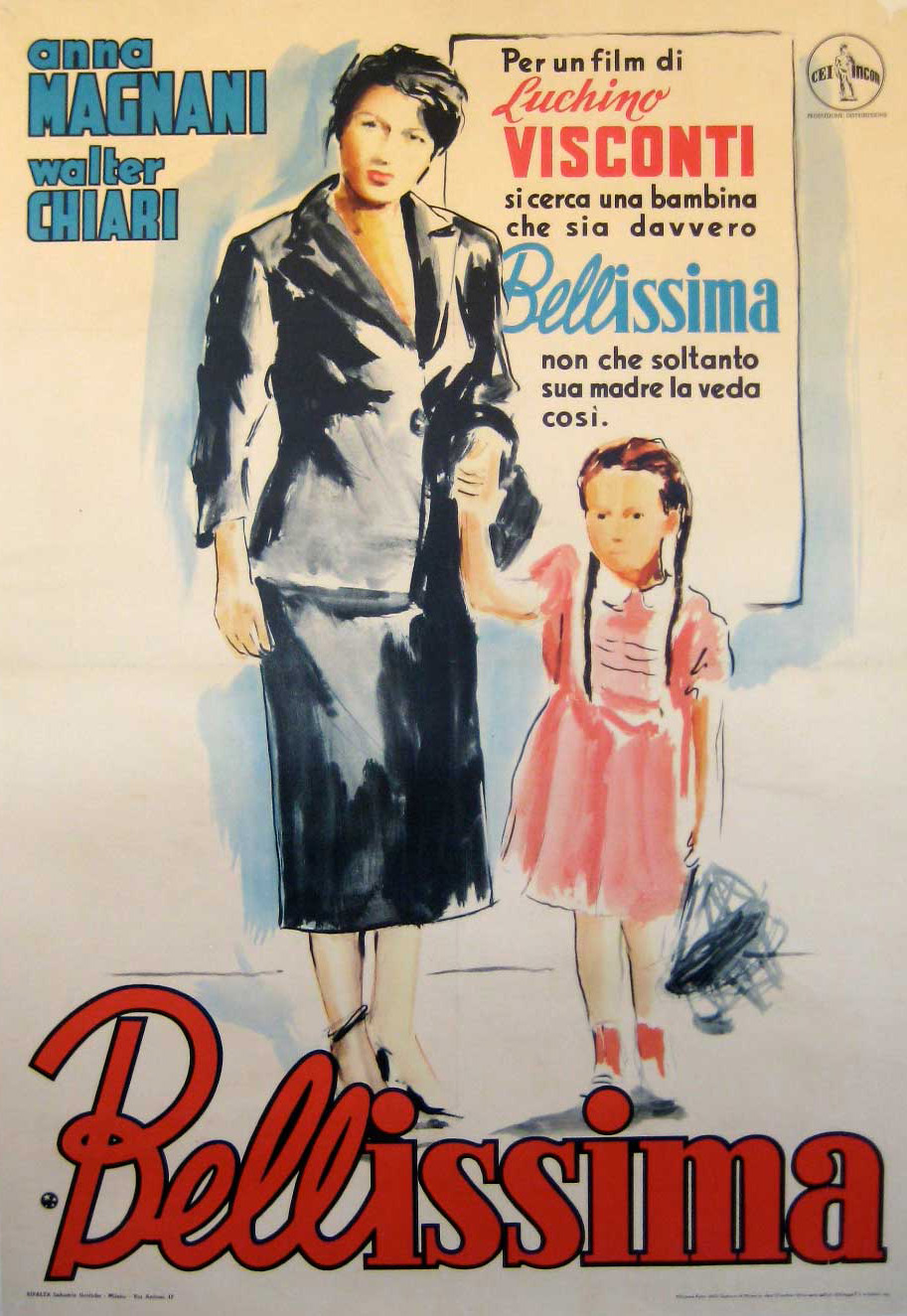
Bellissima (1951), directed by Luchino Visconti, stands as a powerful exploration of ambition, exploitation, and the sacrifices made in the name of love and opportunity. Featuring a riveting performance by Anna Magnani, the film offers a compelling look at the intersection of personal dreams and societal pressures in postwar Italy. Through its intimate narrative and rich character work, Bellissima captures the human condition with extraordinary depth.
The Story of Bellissima
Set in Rome during the burgeoning postwar film industry, Bellissima follows Maddalena Cecconi (Anna Magnani), a working-class mother with dreams of transforming her young daughter, Maria (Tina Apicella), into a film star. When Maddalena learns that a prominent film studio is holding auditions for a new child star, she becomes consumed by the possibility of Maria’s success, believing it to be a ticket to a better life.
Driven by a mix of maternal pride, personal ambition, and societal pressure, Maddalena goes to great lengths to prepare Maria for the audition. She borrows money, clashes with her husband, and faces humiliation as she navigates a world dominated by power and privilege.
As the story unfolds, Maddalena begins to see the exploitative nature of the industry and questions whether the price of fame is worth the toll it takes on her child and herself. The film culminates in a moment of profound realization, as Maddalena confronts her own motivations and the cost of chasing an elusive dream.
Anna Magnani’s Unforgettable Performance
At the heart of Bellissima is Anna Magnani, whose portrayal of Maddalena Cecconi is nothing short of extraordinary. Known for her raw, authentic performances, Magnani imbues Maddalena with a mix of determination, vulnerability, and fierce maternal love.
Magnani’s ability to convey complex emotions through subtle expressions and fiery outbursts makes Maddalena one of cinema’s most compelling maternal figures. Her performance anchors the film, allowing viewers to empathize with her character even as her actions become increasingly desperate. Maddalena’s journey is one of self-discovery, and Magnani’s portrayal ensures that every moment feels authentic and deeply human.
Visconti’s Vision and Social Realism
Luchino Visconti, a pioneer of Italian neorealism, brings his keen eye for detail and social critique to Bellissima. While the film diverges from the stark realism of earlier neorealist works, it retains a strong connection to the struggles of everyday people.
Visconti’s depiction of the film industry serves as a microcosm of postwar Italian society, highlighting the disparities between the working class and the elite. The glamour of cinema contrasts sharply with the harsh realities of Maddalena’s life, underscoring the tension between dreams and reality.
Visconti’s direction emphasizes the small details that bring the world of Bellissima to life, from the bustling streets of Rome to the chaotic energy of the film studio. His use of non-professional actors alongside seasoned performers like Magnani enhances the authenticity of the film, creating a vivid portrait of a society in flux.
Themes of Ambition and Exploitation
Bellissima delves deeply into the themes of ambition, exploitation, and the price of fame. Maddalena’s pursuit of a better future for her daughter reflects the aspirations of many in postwar Italy, a country rebuilding itself after the devastation of World War II.
However, the film does not shy away from examining the darker side of ambition. Maddalena’s blind determination exposes her to manipulation and ridicule, and Maria’s innocence is put at risk in a world that values profit over people. Through these struggles, Bellissima questions the ethics of an industry that thrives on the dreams of the vulnerable.
A Cinematic Reflection of Society
Bellissima is more than a story about a mother and daughter; it is a reflection of Italian society in the 1950s. The film captures the hopes and hardships of the working class, offering a critique of the widening gap between those with power and those without.
Visconti’s choice to set the film within the world of cinema adds a layer of meta-commentary. The audition process becomes a metaphor for the broader societal dynamic, where individuals are judged, commodified, and discarded based on their ability to conform to certain ideals.
The Legacy of Bellissima
While Bellissima may not be as widely discussed as some of Visconti’s later works, its impact on Italian cinema and its exploration of maternal sacrifice remain timeless. The film’s nuanced portrayal of a mother’s love and the human cost of ambition resonates across generations and cultures.
Anna Magnani’s performance continues to be celebrated as one of her finest, embodying the struggles and resilience of countless women. Her work in Bellissima helped solidify her status as one of the most iconic figures in Italian cinema.
Conclusion
Bellissima is a powerful and deeply human film that captures the complexities of love, ambition, and the search for dignity. Through Luchino Visconti’s masterful direction and Anna Magnani’s unforgettable performance, the film offers a poignant exploration of societal pressures and personal aspirations.
As relevant today as it was upon its release, Bellissima remains a testament to the enduring power of cinema to tell stories that reflect the hopes and struggles of everyday life.






